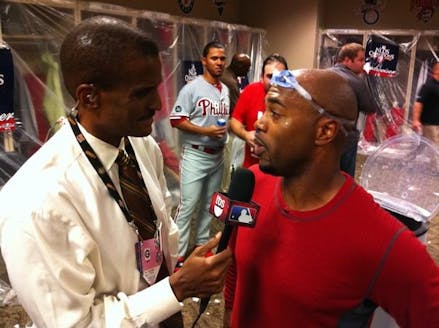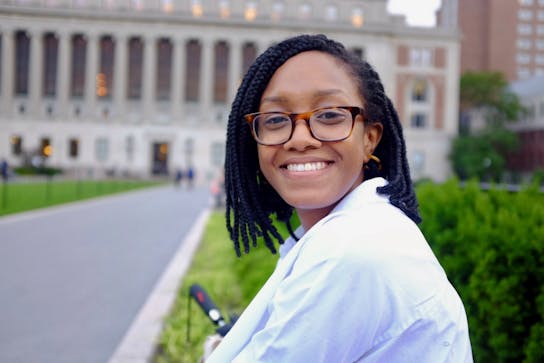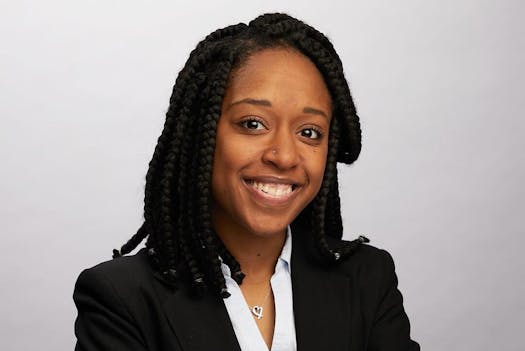Tyrone “Ty” Harris was among the first group of Frederick Douglass Scholars to arrive at American University in 1968. The program started as a merit-based scholarship targeted at recruiting local D.C. high school students. In 2009, the scholarship evolved into the Frederick Douglass Distinguished Scholars program.
“I had to learn how to be the only Black guy in the room. I had to learn how to be in the minority. I had to learn how to represent myself, while I was also representing an entire group of people,” Harris said. “Because a lot of times, when white people came into contact with me in those environments, I was one of the few Black people who they had interacted with in their entire lives.”
Tyrone’s brother, Joseph Harris, began at AU two years earlier in the fall of 1966. Tyrone watched as his older brother and a handful of other Black students formed one of the first Black student unions at a predominantly white university. OASATAU, short for the Organization of African and Afro-American Students at the American University, provided a space for Black students at AU to find a community, advocate for themselves and emphasize their culture.
OASATAU worked with campus administrators to create the Frederick Douglass Scholarship program. Mark and Kendra Harris later followed in their brothers’ footsteps and attended AU under the FDS program.
“What my brother and his peers started, I think was essential and critical to how things have evolved,” Tyrone Harris said. “I think anything that has happened since they've been there, especially if it's related to the success that any Black person has had, I think that we all stand on their shoulders.”
The Harris family created a lasting legacy for the African American community at AU, but they were not the first, or last, trailblazers to affect the landscape of the Black community and impact at the University.
Finding a Community Voice
OASATAU began publishing a Black student newspaper titled UHURU in 1970. The newspaper began as an independent publication, but between 1983 and mid-1989, UHURU ran as an insert in The Eagle.
The Eagle’s first Black editor-in-chief David Aldridge, who graduated from AU in 1987, recalls when he first began to work for The Eagle.
“I wandered into what was then 227 Mary Graydon Center the second day I was on campus, and I didn’t leave for four years,” Aldridge said.
In his first year on staff, Aldridge wrote for both UHURU and The Eagle. During his sophomore year, he became assistant campus news editor, which required him to focus more on his work with The Eagle. Aldridge was elected to the position of editor-in-chief, a position usually given to a senior, in his junior year.
“I was hoping that during my year [as EIC], we would do what I think [The Eagle] has been doing the past few years, which is if we actually cover everyone on campus, we wouldn’t need to do an UHURU,” Aldridge said. “That was my whole point. The Eagle should be for everybody, it should be a paper that everybody wants to read.”
Today, Aldridge works as the EIC for the D.C. bureau of The Athletic. He credits his time at AU as having “everything” to do with where he ended up. Along with his work on other news publications and sites, Aldridge worked as ESPN’s national NBA correspondent and was featured in “The Last Dance,” a documentary released in 2020 about Michael Jordan.

“Going to AU changed my life. It’s not that I would have had a bad life if I hadn’t gone to AU, but I know that going to AU made what happened subsequently in my life possible,” Aldridge said. “It’s difficult enough to be 18-21 years old, it’s really hard when you’re the only person of color in the room, like all the time. That was a constant feature throughout my four years at AU. It’s difficult. But the thing that helped was that I really did make a lot of wonderful friends when I was there.”
AU alumna Elisha Brown and Taryn Daniels relate to Aldridge’s sentiments about being Black students involved in student media.
Brown and Daniels, who both graduated from AU in 2017, joined the American University Association of Black Journalists in 2015.
“I was involved in a few other writer organizations on campus that were very established,” Daniels said. “But while I was there, I was one of the only faces of color, and I had a few instances where the e-boards and editors-in-chief of those organizations would ask me to write articles that felt like it was only given to me because I was Black, and that felt very isolating, I felt very tokenized.”
In 2016, Brown and Daniels created The Blackprint, a publication that works to spotlight students of color and serves as a safe space for journalists of color.
“We just really wanted something that we felt like we could relate to in terms of media, kind of create our own little niche within the existing student media,” Brown said.
But the creation of a new campus publication was not seamless. Brown and Daniels had to fight for their position in AU student media.

“A lot of people weren’t understanding why there was a need for this secondary platform. It was [Brown] and I having to have those tough conversations with various e-boards, with advisers, with SOC and the larger administration saying ‘hey, this is what we’re doing and this is why we need it,’” Daniels said. “It did feel like in those initial conversations that we were fighting against an established system. But you know, nothing ever gets created without a little bit of elbowing.”
Not long after The Blackprint was established, AU’s first Black female AUSG president, Taylor Dumpson, was elected. However, she was met with a racist hate crime her first day in office.
“There were a lot of charged incidents on campus, we had students of color looking for a voice, looking for an outlet to talk more about how they felt and to feel like they were being represented,” Daniels said. “We were able to take what we were feeling and take what our peers were feeling and put it into that inaugural batch of content, and I think that’s what got us recognized and helped to establish Blackprint as the voice that it now is.”
Creating Policy
Dumpson, class of 2018, was forced to navigate the first days of her presidency amid a cloud of chaos and confusion.
“I felt like I was in the middle of a bullseye, when you’re the first person to do things, everything you do is underneath a microscope,” Dumpson said. “And it’s a little bit different when you come into office in the way that I came into office.”
The morning after her election, AU discovered that someone had hung bananas on nooses around campus with racist remarks targeting Dumpson and her historically Black sorority, but she continued in her position to fight for change. Following the hate crime, Dumpson was harassed online by the owner and followers of a neo-Nazi website. She filed a lawsuit against the website’s owner in 2018 and was awarded $725,000 in damages.
“Every student, no matter where they come from, no matter who they are, deserves to be able to have access to go to school,” Dumpson said. “You can’t learn in an environment that is so hostile and antagonistic that it becomes debilitating and dehumanizing. Every student needs to be able to thrive.”
Dumpson took that mindset and ran. During her time as president, she created the Hub for Organizing, Multiculturalism and Equity, a space for multicultural communities and their allies. Dumpson is pleased with how her successors continued to build the space.

“HOME was really grown out of the fact that before that, AU didn’t have a tangible physical space. HOME wasn’t supposed to be a band-aid to solve AU’s racism, HOME was supposed to be a building block,” Dumpson said. “And students have done exactly what I had hoped students would do, which is to be like HOME is not enough, HOME was never supposed to be enough, students were supposed to continue to ask for more and continue to push the University.”
In times of struggle, Dumpson looked to her predecessor, Devontae Torriente, for help.
Torriente, elected in 2016, was the first Black AUSG president. Norman Early was the first Black student body president in the 1960s under the then American University Student Association.
“There was a big context around which students would be needing to have their voices heard on campus, and I wanted to be the one to leverage that and make sure those pieces were being heard and including that racial justice and overall equity framework into that conversation,” Torriente said.
Torriente reflected on helping with the early stages of creating AUx, a program for first-year students.
“We were pushing for the curriculum to be overhauled in a sense, and to have these conversations and classes and assignments on racial and social justice,” he said.
The Continued Fight
Vice President of Campus Life and Inclusive Excellence Fanta Aw began at AU as an undergraduate in 1987, later earning a bachelor’s degree in accounting.
“There was a very vibrant student leadership of the Black student organizations on campus. And for me, coming originally from West Africa, I had my foot in lots of different places,” Aw said. “I had my foot in the international student world, in the Black and African student organizations and all of that. I often say it brought all of the different parts of my identity together, in my time that I was there.”
Aw commends the Black student leaders that came before and after her, saying there has always been a consistent presence of Black trailblazers on AU’s campus.
“I think they’ve had tremendous influence, and the influence has been on different levels. It has affirmed for all the Black students that yes, they too can,” Aw said. “They looked at issues that were of critical importance to students in general while also taking a lens and looking at students who in many ways either felt disenfranchised and didn’t feel like they had a voice at the table. So they really had to navigate multiple worlds in doing so.”





